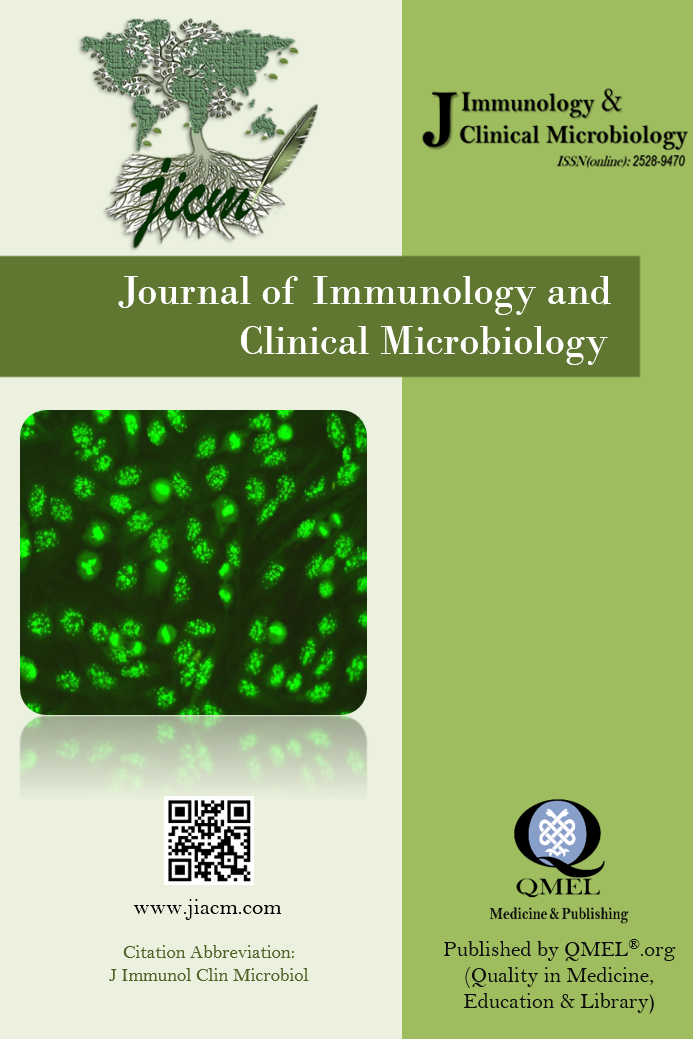Investigation of hospital-acquired infections in units other than the intensive care unit
Investigation of hospital-acquired infections in units other than the intensive care unit
Hospital-acquired infections, prevalence, McCabe score,
___
- References1.Alp E, Leblebicioglu H, Doganay M, Voss A. Infection control practice in conutries with limited resources. Ann ClinMicrobiolAntimicrob. 2011;10:36.2.Vincent JL, Rello J, Marshall J, et al.International study of the prevalence and outcomes of infection in intensive care units. JAMA 2009; 302(21):2323–29.3.Emori TG, Culver DH, Horan TC, Jarvis WR, White JW, Olson DR et al. National nosocomial infections surveillance system (NNIS): description of surveillance methods. Am J Infect Control. 1991;19(1):19-35.4.Öztürk R. Recent Developments related to Infection Control in Turkey. ANKEM Derg.2011;25(Ek 2):9-16.Available from: https://www.ankemdernegi.org.tr/ANKEMJOURNALPDF/ANKEM_25_Ek2_0_0.pdf5.TC Sayıştay Bakanlığı Performans Denetimi Raporu. Hastane enfeksiyonları ile mücadele. Erişim: http://www.hider.org.tr/Yeniden/2007-2hastaneenfeksiyon.Pdf6.Turkish Republic Health Instution Department of Infectious Diseases. Agent distribution and antibiotic resistance surveillance report for national healthcare-associated infections 2017. Available from: https://infline.saglik.gov.tr/7.Reilly JS, Coignard B, Price L, Godwin J, Cairns S, Hopkins S et al.The reliability of the McCabe score as a marker of co-morbidity in healthcare associated infection point prevalence studies. J Infect Prev. 2016;17(3):127-9.8.Horan TC, Andrus M, Dudeck MA. CDC/NHSN surveillance definition of health care-associated infection and criteria for specific types of infections in the acute care setting. Am J Infect Control. 2008; 36(5):309-32.9.Clinical and Laboratory Standards Institute (2013) Performance Standards for Antimicrobial Susceptibility Testing, Twenty-Third Informational Supplement. Avaliable at: https://clsi.org/media/2663/m100ed29_sample.pdf 10.Dereli N, Ozayar E, Degerli S, Sahin S, Koç F. Three-year evaluation of nosocomial infection rates of the ICU. Braz J Anesthesiol. 2013;63(1):73-811.Erdem H, Inan A, Altındis S, Carevic B, Askarian M, Cottle L, et al. Surveillance, control and management of infections in intensive care units in Southern Europe, Turkey and Iran--a prospective multicenter point prevalence study. J Infect. 2014;68(2):131-40.12.Erdem H, Dizbay M, Karabey S, Kaya S, Demirdal T, Koksal I, et al. Withdrawal of Staphylocoocus aureus from intensive care units in Turkey. Am J Infect Control. 2013;41(11):1053-8.13.Tukenmez Tigen E, Dogru A, Koltka EN, Unlu C, Gura M. Device-associated nosocomial infection rates and distribution of antimicrobial resistance in a medical-surgical intensive care unit in Turkey. Jpn J Infect Dis. 2014;67(1):5-8.14.Ellidokuz H, Uçku R, Uysal U, Abacioğlu H. Hospital-aquired infections in elderly patients: results of a West Anatolian University Hospital survellance. Arch Gerontol Geriatr. 2003;37(3):259-63.15.Metintas S, Akgun Y, Durmaz G, Kalyoncu C. Prevalance and characteristics in a Turkish university hospital. Am J Infect Control. 2004;32(7):40-1.16.Wright SB, Ostrowsky B, Fishman N, Deloney VM, Mermel L, Perl TM. Expanding roles of healthcare epidemiology and infection control in spite of limited resources and compensation. Infect Control Hosp Epidemiol. 2010;31(2):127-3217.Samuel SO, Kayode OO, Musa OI, Nwigwe GC, Aboderin AO. Nosocomial infections and the challenges of control in developing countries. Afr J Cln Exper Microbiol. 2010;11(2): 102-110.18.Lyytikäinen O, Kanerva M, Agthe N, Möttönen T, Ruutu P; Finnish Prevalence Survey Study Group. Healthcare-associated infections in Finnish acute care hospitals: a national prevalence survey, 2005. J Hosp Infect. 2008;69(3): 288-94.19.Çelebi G, Pişkin N, Aydemir H, Öztoprak N, Külah C, Demiroğlu Y. Nosocomial Infections Surveillance in Zonguldak Karaelmas University Hospital. Hastane Infeksiyonları Derg. 2006;10:82-190.20.Karahocagil MK, Yaman G, Göktaş U, Sünnetçioğlu M, Çıkman A, Bilici A, ve ark. Hastane enfeksiyon etkenlerinin ve direnç profillerinin belirlenmesi. Van Tıp Derg. 2011;18 (1):27–32. 21.Saçar S, Kavas ST, Asan A, Cevahir N, Serin S, Turgut H. Surveillance of nosocomial infections in Pamukkale University Hospital: 3-year analysis. İnfeksiyon Derg. 2008; 22 (1):15-21.22.ECDC. Point prevalence survey of healthcare associated infections and antimicrobial use in European acute care hospitals. Available from: http://www.nsih.be/download/ECDC%20PPS/ECDC_PPSII_HAI_AU_Protocol.pdf.
- Yayın Aralığı: Yılda 4 Sayı
- Başlangıç: 2016
- Yayıncı: Erkan YULA
High Eosinophilia Strongly Associated with Human Toxocariasis
Ayşegül AKSOY GÖKMEN, Aylin BABAOĞLU, Bayram Pektaş PEKTAŞ, Selçuk KAYA, Derya DİRİM ERDOĞAN, Metin KORKMAZ
Investigation of hospital-acquired infections in units other than the intensive care unit
Şebnem ÇALIK, Alpay ARI, Bengisu AY, Özlem Yüksel ERGİN, Selma TOSUN
Selçuk KAYA, Mehmet KARABEY, Serdar GÜNGÖR, Nurten BARAN, Aslı Gamze ŞENER, İlhan AFŞAR
Routine Surgical Drainage in Tubo-ovarian Abscess: Single Center Experience with Fifty Patients
Aysu AKCA, Gulseren YİLMAZ, Nevin TUTEN, Berna ASLAN CETİN
Meme Kanserinin Palpable Olması veya Palpe Edilmemesinin Prognostik ve Prediktif Değeri
